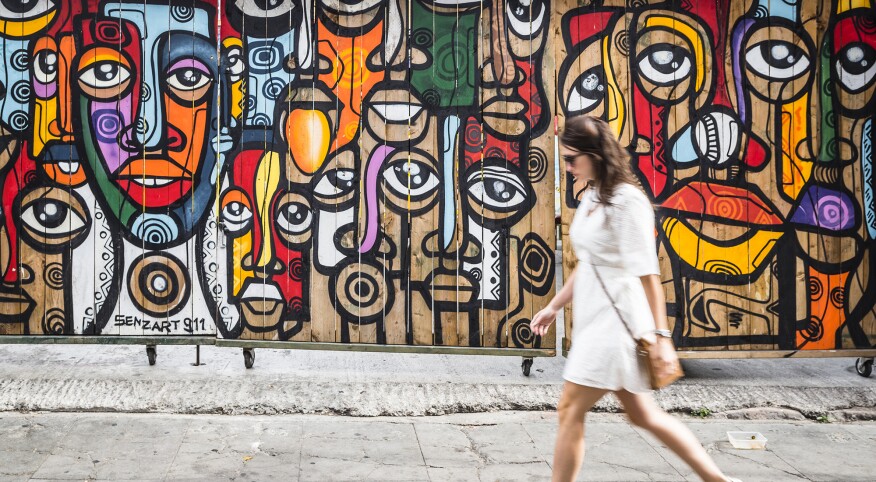When I first visited London, I was 19 years old and instantly smitten. All the English icons I knew from popular culture were right there: Red double-decker buses! Bobbies with nightsticks — just like in Monty Python! Palace beefeater guards — just like on the gin bottles! Abbey Road’s famous crosswalk was just like the Beatles’ album! Cockney flower sellers in Covent Garden sounded like hawkers in Oliver and Mary Poppins! Even brutalist housing projects thrilled me: These were the “council tenancies” the Sex Pistols had sung about!

And then, of course, there was the queen and all her imperial bling. London, at first glance, was a wonderland where Anglo mythology came to life, where fairy tales, rock ’n’ roll and movie musicals existed in real-time. But being a native New Yorker, what blew my mind most, I’m appalled to admit, were the Cadbury machines in the London Underground.
“You can buy chocolate bars in the subways here?” I cried. “And nobody tries to mug you?”
Today, almost 40 years later, I still feel giddy whenever I land in Heathrow. Visiting London is always a reunion with my first great love. Yet, what makes London such a mainstay in my heart is neither its touristy cliches nor its candy. For me, the city’s history has been a life changer. London was where I lost my “global virginity.” It awakened me to the much bigger world beyond the U.S. — and my place in it.

Although I prided myself on being a street-smart Manhattanite, the truth was that when I first landed in the British capital, I was stunningly naïve. As a child during the Vietnam War, I hadn’t been allowed to watch television news. Anytime relatives heard immigrant success stories, they proclaimed, “Only in America.” When I studied the Holocaust in school, teachers assured me that such atrocities of the past “can’t happen here” because “America is a democracy like no other.” As such, I’d grown up — as other middle-class Americans of my generation did — thinking that war happened someplace else, that history was from “the olden days” and that America was exempt from it.
Yet London hasn’t been exempt from history for over 1,000 years. Many landmarks dwarf anything we Yanks consider old in our own country. The Tower of London, I was amazed to discover, was not a re-creation, but the actual structure dating back to 1066. Westminster Abbey held the tombs of real kings and poets. And the Churchill War Rooms blew my mind: This small underground warren was Churchill’s real headquarters during WWII. The very maps, radios and telephones he used remained right where he left them.

My truly apocryphal moment came, however, at a crafts fair outside St. James Church in Piccadilly. There, I noticed a shattered balustrade. A plaque explained that the church had been bombed during the blitzkriegs of WWII. Suddenly, I saw it: the church nearly in ruins — its spire rising amid piles of rubble — superimposed on the restored church now, with artisans selling dream-catchers outside.
Heading into the London Underground, it then occurred to me that older people waiting on the train platform could’ve slept there, in that very station, during the blitzkrieg. Today, they might be using it to take the Bakerloo Line to their dentist.
When I’d first arrived in London, I’d joked that it was “like New York City, but with better accents.” Now I was seeing that city people — who lived and looked very much like me — had experienced war and all the precarities of the world right there in their hometown. It was an Annie Sullivan-with-Helen-Keller-at-the-water-pump moment for me — the instant when I connected the word “history” to the palpable, living reality of it.

No one, I realized, was immune from history. Not even Americans. It could hit anyone, anywhere. It could fall right out of the sky.
For post-9/11 Americans, this is hardly a revelation. But for me in 1985, it was the first time I grasped the connective tissue between myself, my country and the rest of the world. It was a crucial turning point, a dilation of my perspective. I became far more connected and aware. I began to understand how all of us are vulnerable to world events and no one is exempt from humanity. It made me live — and write — with greater humility.
Now when I visit London, I go beyond the obvious tourist draws. The city is about the future as much as the past. Britain’s imperialism has given way to a dynamic, 21st-century city whose diversity dwarfs Big Ben. It’s an amazing place to simply wander. Once-blighted neighborhoods such as Islington, Battersea and Spitalfields have become uber-cool districts full of galleries and boutiques. Terrific street markets thrive in Brick Lane, Portobello Road and Camden. Off-the-beaten-track walking tours such as Secret London, The Unknown East End, Black History Walks, and Little Venice bring hidden jewels to life.
Major exhibitions at the Victoria & Albert Museum this year celebrate multiple cultures. Modern architecture pushes boundaries. In the ‘80s, English food was so appalling (steak and kidney pie, anyone?), all I could stomach were pub meals called Ploughman’s Platter: cheddar, chutney and bread. Today, London is a gastronomic mecca, offering Michelin-starred restaurants, at least five of which are Indian (try Gymkhana for a splurge). There are wine bars up the wazoo and loads of modern global cuisine to feast on. (Ottolenghi’s restaurants are among my favorites.) Yes, high tea at the Ritz is still great. Ditto for theater in the West End, St. Paul’s Cathedral, pubs, the Royal Academy of Arts, Hyde Park and Harrod’s. And everyone needs to pose dementedly in front of Buckingham Palace at least once.

But a greater, more complex London is emerging from the end of an empire. Go. Walk. Absorb its past, present and future as they collide. This fabulous city, I find, always has something to teach.
Would you just love to travel the world without actually leaving the U.S.? Then check this out.
Have you ever been to London? What do you love about the city? Let us know in the comments below.








